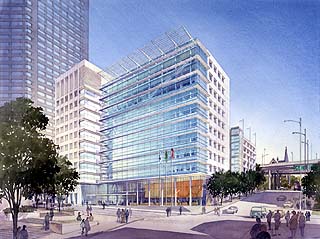|
Subscribe / Renew |
|
|
Contact Us |
|
| ► Subscribe to our Free Weekly Newsletter | |
| home | Welcome, sign in or click here to subscribe. | login |
Architecture & Engineering
| |
November 5, 1999
Justice building is first phase of $224 million Civic Center
By ANNU MANGAT
Journal A/E editor
Architects from NBBJ provided the Seattle Design Commission on Thursday with a few glimpses into what shape the city's new municipal courts and police headquarters is likely to take.
Dubbed the Justice Center, the building will be located on Fifth Avenue, between Cherry and James streets. It is the first phase of Seattle's ambitious plan for a new $224 million Civic Center, which includes a new City Hall, a landscaped public plaza and tenant improvements of the city-owned Key Tower. Other aspects of the plan include retaining the Arctic building for city offices and selling off the Dexter Horton and Alaska buildings.

|
Plans call for a 12-story structure that will house what the architects termed "two identities"-- one for the police department's administration headquarters and another for the city's courts. The lobby would house both police and court functions. The middle floors would be reserved for police, and the top three floors would contain courtrooms and jury rooms.
It's a "no-brainer" that the public should have the best views possible in the building, said Dennis Forsyth, NBBJ principal and project manager.
Judges' chambers are sandwiched between two courtroom floors, so judges would only need to walk up or walk down one flight of stairs to reach their courtrooms.
The court-oriented component of the building will feature a glass wall that looks toward the public plaza. Police functions will be expressed in the building with stone cladding (the color and type have yet to be determined).
The glass wall, which is the building's most prominent exterior feature, would not only offer views of Elliott Bay but would serve as a thermal buffer, Zieve said. He added that maximizing energy efficiency is a primary challenge in the design of the glass wall. He also noted that sustainable design throughout the building is a central goal.
Alluding to the new City Hall, Zieve said the Justice Center would function as a "foil for the more vigorous building across the street." He said the Justice Center design team is "working closely" with City Hall lead architect Peter Bohlin to integrate design of the two buildings.
A two-story lobby will visually connect the Justice Center with the public plaza and the new City Hall.
Though details are being worked out, preliminary plans for artwork on the site include a "water wall" that takes advantage of the dramatic quality of the site's natural slope. Lead artist for the Justice Center Pam Beyette said the goals is to "integrate art seamlessly into the landscape."
Apart from describing preliminary design principles for the project, Forsyth reported to the Design Commission that "we're right in the ballpark with relation to cost." Forsyth, who led the design of Safeco Field, said the construction cost of the new courthouse and police administration building now stands at $69.5 million, slightly more than the initially budgeted $69.2 million. He said that at 293,000 gross square feet, the size of the building is also "a little over what we planned."
Asked about including artwork in the courtrooms, Zieve agreed it would be a good idea but expressed concern about "spreading our money too thin." The Justice Center budget for art is $800,000, which Design Commission chairperson Rick Sundberg remarked "doesn't go that far."
The Justice Center will also feature a rooftop trellis. That feature, Zieve explained, will help define a terrace, which is adjacent to jury deliberation rooms. A light shaft, or light well, spanning the third to the eighth floor will help maximize light on the site. The light well will also help illuminate the rear side of the building, which is shadowed by a large parking garage, he said.
Asked how a courthouse should be expressed architecturally, Zieve said it's not about Ionic columns and a large pediment but the use of classic architectural principals. Proportion, scale, quality of materials and detailing will guide the design, he said.
The Design Commission expressed enthusiasm for the project, and, in particular, credited the design team with tackling issues of sustainable design up front. With the praise, however, came some gentle criticism. Sundberg suggested the design team consider making the police entrance look more publicly accessible, noting that it appeared to dive below grade. He also recommended the design team "get moving" on the issue of integrating the Justice Center with Key Tower. That topic is likely to resurface at the next meeting of the Design Commission in December.
Design development for the Justice Center should be complete by the end of January, with major construction beginning in October 2000. Completion for the building is scheduled for April 2002.
The city is in the process of selecting a general contractor/construction manager for the Justice Center and is expected to make a final decision in a few weeks.


